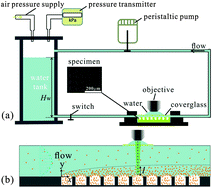Influence of fluid flow on the stability and wetting transition of submerged superhydrophobic surfaces
Abstract
Superhydrophobic surfaces have attracted great attention for drag reduction application. However, these surfaces are subject to instabilities, especially under fluid flow. In this work, we in situ examine the stability and wetting transition of underwater superhydrophobicity under laminar flow conditions by confocal microscopy. The absolute liquid pressure in the flow channel is regulated to acquire the pinned Cassie–Baxter and depinned metastable states. The subsequent dynamic evolution of the meniscus morphology in the two states under shear flow is monitored. It is revealed that fluid flow does not affect the pressure-mediated equilibrium states but accelerates the air exchange between entrapped air cavities and bulk water. A diffusion-based model with varying effective diffusion lengths is used to interpret the experimental data, which show a good agreement. The Sherwood number representing the convection-enhanced mass transfer coefficient is extracted from the data, and is found to follow a classic 1/3-power-law relation with the Reynolds number as has been discovered in channel flows with diffusive boundary conditions. The current work paves the way for designing durable superhydrophobic surfaces under flow conditions.


 Please wait while we load your content...
Please wait while we load your content...